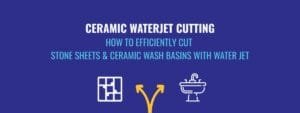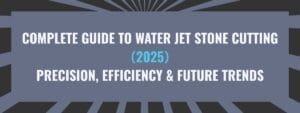Water jet cutters are widely used in stone, metal, glass, rubber, and composite materials industries because they can cut almost any material with high precision. Unlike traditional cutting tools, water jets use high-pressure water, sometimes mixed with abrasive particles, for cold cutting, reducing material damage and improving quality.
While water jet machines have many components, only five are essential. Optional features and advanced table and head designs further improve cutting speed, safety, and convenience, tailored to different materials and industries.
The Five Essential Parts
1. High-Pressure Pump
The pump is the heart of a water jet cutter, pressurizing water to 46,400–87,000 psi (320–600 MPa). Pumps come in different sizes and power levels. For example, metal cutting often uses high-power pumps (45kW or 75kW) to increase cutting speed and productivity. Softer materials like foam or rubber require only standard pumps.
2. Cutting Table
The cutting table holds materials securely for precise cutting. Standard tables have a loading capacity of 500 kg/m² with a slats surface for stone. For heavy metals, the table can be upgraded to 1000 kg/m², with either a super-flat table or grated surface, depending on the material.
The vertical distance (Z-axis) of the cutting head is usually 150 mm. Bridge-style tables can extend this to 250 mm, and high-frame tables can reach up to 2000 mm for large or thick workpieces.
For safety and convenience, tables can feature auto up-down gates or 2-sides gates, preventing accidental contact and simplifying waste cleanup. The control display can be integrated into the table or suspended above it, eliminating the need for a separate standing IPC, saving space and improving aesthetics.
3. Cutting Head
The water jet cutting head usually has three-axis movement (X, Y, Z) for standard flat cutting. Advanced configurations offer 5-axis cutting:
- AB 5-axis: small tilt up to ±12°, suitable for minor angled cuts or slightly complex shapes
- AC 5-axis: large tilt up to ±75°, ideal for 3D cutting or deep angled operations
Nozzle size and pump power can be adjusted depending on cutting needs:
- Fast downward cuts: use a larger nozzle with a high-power pump for increased cutting speed
- High-quality edges: use a smaller nozzle to achieve smoother, more precise cuts
Optional enhancements include multi-head setups for batch cutting soft materials and auto-edge tracking for large or heavy samples. The choice of three-axis or five-axis depends on the sample: flat cutting uses three axes, while 3D shapes or angled cuts require five-axis motion.
4. Abrasive/Sand Supply System
Essential for cutting hard materials like metals, stone, and composites. Soft materials or food products do not require abrasives, which reduces maintenance and costs.
5. Control System (Software / CNC)
Modern CNC software allows programming of cutting paths, speed, and water pressure, supporting complex shapes and automated, repeatable operations.
Optional Features That Improve Safety and Efficiency
- Anti-Collision Device – Protects tubes and cutting head from damage
- Sand Removal System – Automatically clears spent abrasive, saving labor
- Safety Light Curtain – Provides warning and operator protection
- Remote Controller – Monitors positions and machine status remotely
- Laser Height Sensor – Ensures consistent cutting depth for stone
- Loading Lifter / Roller Tables – Facilitate handling large sheets of glass or stone
- High-Power Pumps / Fast-Moving Heads – Reduce metal cutting time
- Auto-Edge Tracking – Keeps cuts precise on heavy or hard-to-move samples
- Multi-Heads – Useful for rubber or soft material batch production
- Drilling Function – Helps cut multiple layers of composite materials
- Water Softener – Protects pumps and piping in hard water areas
- Oil Cooling System – Extends pump life in hot environments
Industry Applications
- Stone – Must-have parts plus laser height sensors and anti-collision devices for accuracy and safety
- Glass – Roller tables, loading lifters, and integrated displays enhance handling efficiency
- Metal – High-power pumps, fast heads, and auto-edge tracking improve speed and precision
- Rubber and Soft Materials – Multi-head cutting allows batch production
- Multi-Layer Composites – Drilling functions enable clean, precise cuts
- All Industries – Optional features like anti-collision, sand removal, safety light curtains, and remote control improve overall safety and convenience
Water jet cutters rely on five essential components: high-pressure pump, cutting table, cutting head, abrasive supply system, and CNC control software. Optional features, advanced table designs, and flexible cutting head configurations make cutting faster, safer, and easier, depending on industry needs.
Understanding which parts are essential and which are optional helps businesses save costs, increase productivity, and maintain high-quality, safe operations. From stone and metal to glass, rubber, and composite materials, water jet cutters provide flexible solutions for modern manufacturing.



